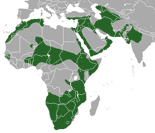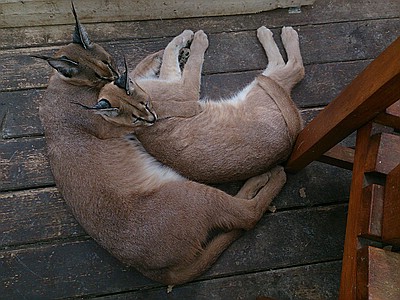information about Caracal
the Caracal - Caracal caracal
hunter and hunting assistant
The caracal is distinguished from Felis by the presence of a long tuft on the tip of the ears, exceeding half their length. No trace of pattern remains in the coat, except a few spots on the underside and inside of the fore legs. It is a slender, long-legged cat of medium size with a relatively short tail. The fur on the back and sides is generally of a uniform tawny grey or reddish, frosted-sand colour. The belly and the undersides of the legs and chest are whitish and spotted or blotched with pale markings. The tufted ears are black-backed. The skull is high and rounded. The jaw is short, stoutly built, and equipped with large, powerful teeth. Males reach a head and body length of 75 to 105.7 cm (29.5 to 41.6 in), with a 23.1- to 34-cm-long tail, and weigh 8.0 to 20 kg (17.6 to 44.1 lb). Females are smaller with a head and body length of 69 to 102.9 cm (27.2 to 40.5 in) and a tail 19.5 to 34 cm (7.7 to 13.4 in) long. They weigh from 7.0 to 15.9 kg (15.4 to 35.1 lb).
Facial markings comprise a dark line running down the center of the forehead to near the nose, and another one running from the inner edge of the eye to the nostrils. The pupils of the eyes contract to form circles. A light-colored ring encircles the eyes, and a rather indistinct dark brown patch occurs over each eye. White patches occur on either side of the nose. The inner surface of the pinna is covered with small white hairs. Numerous stiff hairs emerge from between the pads and probably are an adaption for moving through soft sand.
In the past, and even today caracal cats are trained to serve people as a hunting companion.
wanted poster
Body length : 69 cm -- 106 cm
Tail length : 30 cm
Body height : 40 cm -- 50 cm
Weight : 10 kg -- 18 kg
Pregnancy : 68 days -- 80 days
Throw size : 1 - 4 young ones
Sex mature : 12 - 15 months
Life expectancy : 16 years

Distribution and habitat
Caracals are common in parts of their sub-Saharan range, especially in South Africa and southern Namibia, where they expand into new, and recolonize vacant, areas. They occur at much lower densities inCentral and West Africa, where thecarnivore community is more diverse. They occupy a wide variety of habitats from semidesert to relatively open savanna and scrubland to moist woodland and thicket ore evergreen and montane forest such as in the Western Cape of South Africa. They prefer drier woodland and savanna regions with lower rainfall and some cover. They also occur in the Sahara mountain ranges and semiarid woodlands. On the Arabian Peninsula, caracals occur throughout the mountain ranges and hilly steppe regions, but probably do not penetrate far into the great sand deserts of the interior.
Things to know
The caracal has compared to other cats and highest bounce.


 Deutsch
Deutsch Englisch
Englisch Polnisch
Polnisch